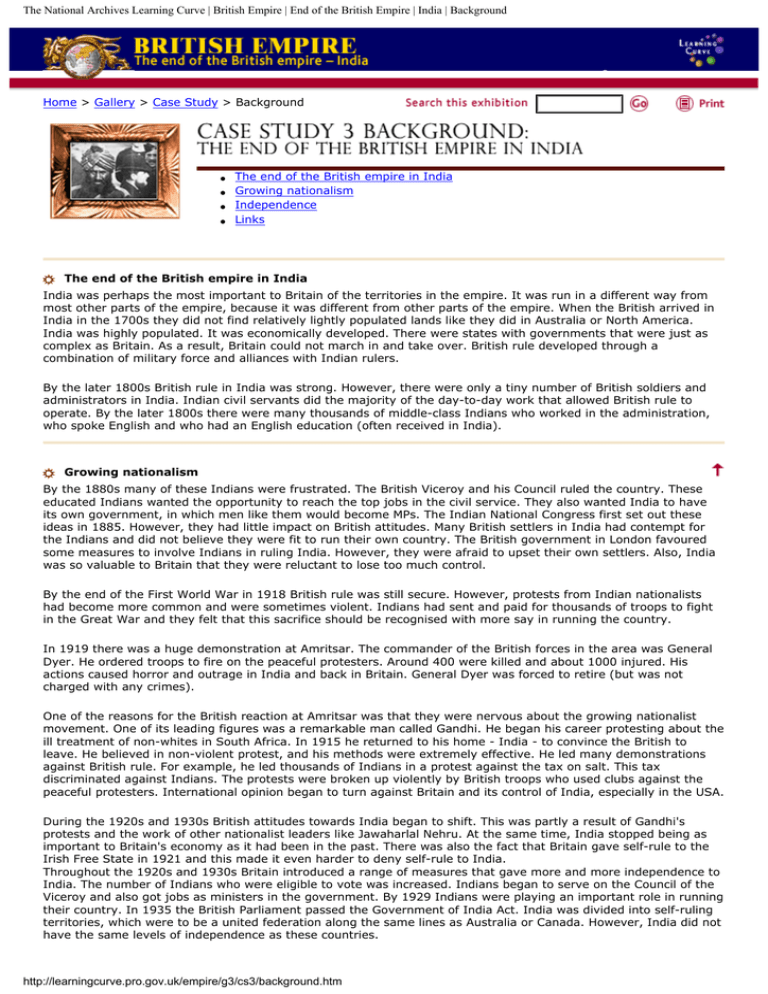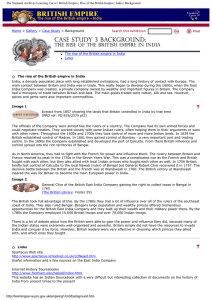Document 11403565
advertisement

The National Archives Learning Curve | British Empire | End of the British Empire | India | Background Home > Gallery > Case Study > Background ● ● ● ● The end of the British empire in India Growing nationalism Independence Links The end of the British empire in India India was perhaps the most important to Britain of the territories in the empire. It was run in a different way from most other parts of the empire, because it was different from other parts of the empire. When the British arrived in India in the 1700s they did not find relatively lightly populated lands like they did in Australia or North America. India was highly populated. It was economically developed. There were states with governments that were just as complex as Britain. As a result, Britain could not march in and take over. British rule developed through a combination of military force and alliances with Indian rulers. By the later 1800s British rule in India was strong. However, there were only a tiny number of British soldiers and administrators in India. Indian civil servants did the majority of the day-to-day work that allowed British rule to operate. By the later 1800s there were many thousands of middle-class Indians who worked in the administration, who spoke English and who had an English education (often received in India). Growing nationalism By the 1880s many of these Indians were frustrated. The British Viceroy and his Council ruled the country. These educated Indians wanted the opportunity to reach the top jobs in the civil service. They also wanted India to have its own government, in which men like them would become MPs. The Indian National Congress first set out these ideas in 1885. However, they had little impact on British attitudes. Many British settlers in India had contempt for the Indians and did not believe they were fit to run their own country. The British government in London favoured some measures to involve Indians in ruling India. However, they were afraid to upset their own settlers. Also, India was so valuable to Britain that they were reluctant to lose too much control. By the end of the First World War in 1918 British rule was still secure. However, protests from Indian nationalists had become more common and were sometimes violent. Indians had sent and paid for thousands of troops to fight in the Great War and they felt that this sacrifice should be recognised with more say in running the country. In 1919 there was a huge demonstration at Amritsar. The commander of the British forces in the area was General Dyer. He ordered troops to fire on the peaceful protesters. Around 400 were killed and about 1000 injured. His actions caused horror and outrage in India and back in Britain. General Dyer was forced to retire (but was not charged with any crimes). One of the reasons for the British reaction at Amritsar was that they were nervous about the growing nationalist movement. One of its leading figures was a remarkable man called Gandhi. He began his career protesting about the ill treatment of non-whites in South Africa. In 1915 he returned to his home - India - to convince the British to leave. He believed in non-violent protest, and his methods were extremely effective. He led many demonstrations against British rule. For example, he led thousands of Indians in a protest against the tax on salt. This tax discriminated against Indians. The protests were broken up violently by British troops who used clubs against the peaceful protesters. International opinion began to turn against Britain and its control of India, especially in the USA. During the 1920s and 1930s British attitudes towards India began to shift. This was partly a result of Gandhi's protests and the work of other nationalist leaders like Jawaharlal Nehru. At the same time, India stopped being as important to Britain's economy as it had been in the past. There was also the fact that Britain gave self-rule to the Irish Free State in 1921 and this made it even harder to deny self-rule to India. Throughout the 1920s and 1930s Britain introduced a range of measures that gave more and more independence to India. The number of Indians who were eligible to vote was increased. Indians began to serve on the Council of the Viceroy and also got jobs as ministers in the government. By 1929 Indians were playing an important role in running their country. In 1935 the British Parliament passed the Government of India Act. India was divided into self-ruling territories, which were to be a united federation along the same lines as Australia or Canada. However, India did not have the same levels of independence as these countries. http://learningcurve.pro.gov.uk/empire/g3/cs3/background.htm The National Archives Learning Curve | British Empire | End of the British Empire | India | Background The British saw their actions as gradually preparing India to earn its liberty and to rule itself. Indian nationalists saw the British measures as a way of hanging on to power and not giving power to Indians. The Indian National Congress, headed by Nehru, became the focus of the campaign for Indians who wanted to see an end to British rule. Independence Protests continued through the 1930s and even during the Second World War. It should be remembered that India again sent and paid for thousands of troops to fight for the British empire during this war. In fact, the British made an offer of Dominion status to India in 1942 in return for full co-operation during the war. However, there were too many restrictions on this offer and Indian National Congress leader Nehru turned it down. Gandhi and other nationalists continued to demand independence for India throughout the war, although they were careful to avoid disrupting the war effort. When the war ended the protests increased. International opinion, especially in the USA, was increasingly hostile to British rule. Image 1 Photo of Indian troops in Egypt during the Second World War, 1940 (PRO ref: CAB 44/88) One reason why the British were reluctant to leave India was that they feared India would erupt into civil war between Muslims and Hindus. The country was deeply divided along religious lines. In 1946-47, as independence grew closer, tensions turned into terrible violence between Muslims and Hindus. In 1947 the British withdrew from the area and it was partitioned into two independent countries - India (mostly Hindu) and Pakistan (mostly Muslim). Around 2 million people fled from their homes to areas of Pakistan or India where they would not be a minority, violence continued for some time after final partition, and there were disputes over territory between the two newly created countries. Jawaharlal Nehru went on to become the first Prime Minister of India and a key force in making the country a stable, democratic state. Links Chronology of modern India http://www.itihaas.com/modern/index.html Detailed timeline with useful links from specific events Feedback | Credits | Sitemap | Help http://learningcurve.pro.gov.uk/empire/g3/cs3/background.htm Glossary | World Maps Background source 1 Print | Close Photo of Indian troops in Egypt during the Second World War, 1940 (PRO ref: CAB 44/88) Top of page | Print | Close http://learningcurve.pro.gov.uk/empire/g3/cs3/g3cs3s1_bg.htm





